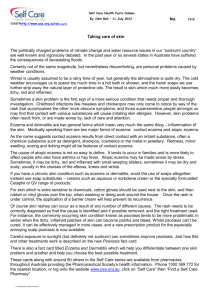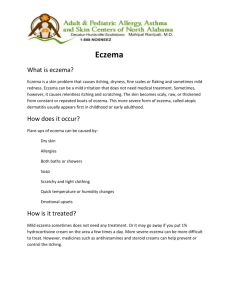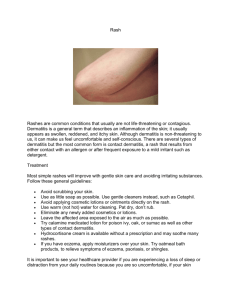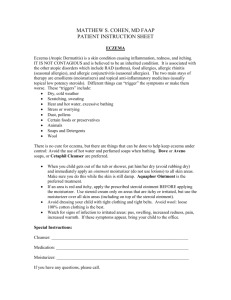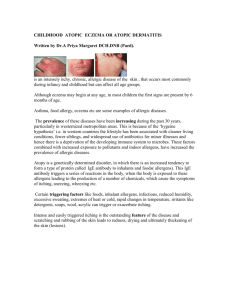File
advertisement
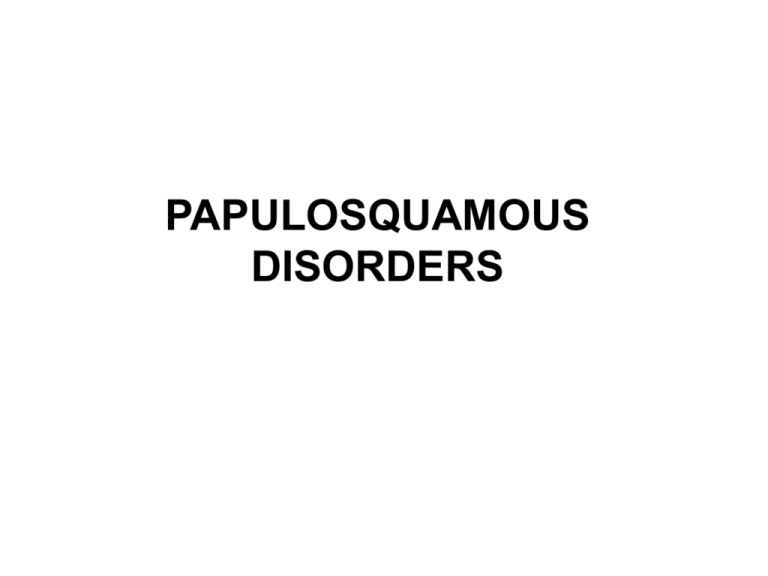
PAPULOSQUAMOUS DISORDERS Papulosquamous eruptions • Also k/a scaly rash disease • Clinical lesions characterized by scaly papules and plaques(may be due to proliferation of cells of epidermis or dermis,infiltration with inflammatory cells or deposits in dermis) • Morphology of papules /plaques varies in different papulosquamous eruption plus there is characteristic scales in each variety. Causes of sudden scaly rash Common • Eczema • Lichen planus • Drug eruptions Psoriasis Secondary syphilis Less common • Pityriasis rosea Pityriasis versicolor • Tinea corporis • Exfoliative erythroderma • Gianotti-Crosti syndrome History • Common presenting problemEruptive scaly rash with or without itching • Differentiation of these diseases are done based upon history and examination Ask • Rash • Location- Ask where the rash is • Is it at multiple places? • Onset, duration and progression • Associated symptoms Ask if the lesion is: • Itchy– Eczema is extremely itchy • Breathing problems/ chest pain/ joint pain/fever/ red eyes- to R/O other systemic diseases • Aggravating factors • Temperature- Itching of acute eczema increases with rise in temperature • Allievating factors • Ask if anything makes the problem better • Cooler temperature in Acute eczema. History taking.. • Past Medical History: Previous H/O similar episodes: • Allergic history: • Medical problems in the past: • Hospitalization: • Family History: • Obstetric and Gynecological history: • Sexual History: • Social History: Mnemonics for history taking: • LIQOR AAA L- Location I - Intensity Q- Quality O- Onset, duration and frequency R- Radiation A- Aggravating factors A- Alleviating factors A- Associated problems • PAM HUGS FOSS P- Previous episodes of C/O A- Allergic History M- Medical problems in the past H- Hospitalization U- Urinary problems G- Gastrointestinal problems S- Sleep Begin with transition question for FOSS F- Family History O- Obstetric and gynecology history S- Sexual H/O S- Social H/O Examination: • Complete exposure, in bright and uniform light • General examination • Local examination: • Rash - Symmetrical/ asymmetrical - Extensor or flexor - Proximal/ Distal/ Facial - Localised or widespread • Examine scalp, face, eyes, oral mucosa, neck, axilla, nails, groin and joints C/F of common scaly rashes Type of rash Distribution Morphology Associated signs Eczema Face/ flexors Poorly defined erythema and scaling Lichenification Shiny nails Infraorbital crease Dirty neck Psoriasis Extensor surfaces Well defined plaque with silvery scale Nail pitting Scalp involvement Axilla and genital areas are often affected Pityriasis rosea Fir tree pattern on torso Well defined erythematous papules and plaques Drug eruption Widespread Maculopapular erythematous scaly areas followed by exfoliation Pityriasis versicolor Upper torso and upper shoulders Hypo and hyperpigmented scaly patches Lichen planus Distal limbs Lower back Shiny flat papules White lacy network in buccal mucosa Tinea corporis Asymmetrical red scaly lesions Scaly plaques Nail involvement Eczema • Eczema literally means ‘to boil out’ • Terms 'eczema' and 'dermatitis' are synonymous. • They refer to distinctive reaction patterns in the skin, which can be either acute or chronic and are due to a number of causes. • It has 2 components: • Clinical • histological Clinical component 0f THE ECZEMA REACTION Acute • • • • • • Redness and swelling, usually with ill-defined margins Papules, vesicles and, more rarely, large blisters Exudation and cracking Scaling Pruritis Erythema Chronic • May show all of the above features, although it is usually less vesicular and exudative • Lichenification, a dry leathery thickening with increased skin markings, is secondary to rubbing and scratching(trIad of hyperpigmentation ,thickening of skin and increased skin markings) • Fissures and scratch marks • Pigmentation changes (hypo- and hyper-) Histological component Hallmarks- (depending on clinical appearance) •spongiosis •Hyperkeratosis and acanthosis In the acute stage, oedema of the epidermis (spongiosis) progresses to the formation of intra-epidermal vesicles, which may enlarge and rupture. In the chronic stage there is less oedema and vesiculation but more thickening of the viable epidermis (acanthosis),thickening of stratum corneum(hyperkeratosis) This is accompanied by a variable degree of vasodilatation and T-cell lymphocytic infiltration in the upper dermis. Histological events in eczema classification Etiological • Endogenous • Exogenous • combined Morphological • Discoid • Hyperkeratotic • Lichenified • Seborrheic Endogenous • Atopic dermatitis • Seborrheic dermatitis • Discoid • Pompholyx • Pityriasis alba • Stasis dermatitis • Lichen simplex chronicus Exogenous • Irritant • Allergic • Photo dermatitis • Radiation dermatitis • Infective dermatitis Combined • atopic Investigations • • • • • • Acute to be treated before investigations Chronic: Patch test Prick test Photopatch test Serological test RAST Differential diagnosis • Psoriasis • Scabies • Any other papulosquamous lesions complications Dermatological complications Infecton Dissemination Contact dermatitis Erythroderma Psychosocial complication Anxiety,depression,social comp. • General measures Removal of trigger Hydration • Acute phase: Treatment topical treatment-soln of either potassium permanganate (0.01%)or aluminium acetate(0.65%)or for large areacalamine lotion /local steroids systemic treatment: short course of steroid , antibiotics,antihistaminics • Chronic phase: nonsteroid-ichthammol,topical steroids,plus keratolytic agents like salicylic acid or urea(for lichenified lesion)antibiotics Atopic eczema/ dermatitis • Most common form • It is an endogenous eczema triggered by exogenous agents characterised by extremely pruritic recurrent ,symmetric eczematous lesion • Epidemiology: Seen in 3% of all infants , increasing worldwide(decr.breast feeding and increasing pollutants) Etiology and pathogenesis Genetic predisposition maternal imprinting-that is, they are inherited more often from the mother than from the father Immunological changes: IgE levels,abnormal lymphocytes: Generalized and prolonged hypersensitivity to common environmental antigens Atopic Eczema Associated features:Positive H/O or Family H/O Asthma, Hay fever, Urticaria or food allergies Clinical features andDistribution of rash Infantile phase •Begins after age of 3 mths,intensely itchy papules and vesicle which soon become exudative,secondayry infection is commn • Face and trunk • Napkin area is spared Childhood phase •Dry ,leathery and extremely itchy plaques • Back of knees, front of elbows, wrists and ankles Adults phase •Lesions are very itchy,lichenified plaques • cubital and popliteal fossae and sometimes neck and low grade involvement in rest of the body •Discoid pattern may be seen on hands and feet • Lichenification is common Course of atopic dermatitis Infantileeczema in 3%of popln 40% clear by age of 18mths 60%develop childhood eczema 70%clear by the age of 10yrs Adult eczema Diagnostic criteria for atopic eczema Itchy skin and at least three of the following H/O itch in skin creases or cheeks if <10yrs H/O asthma/ hay fever (or in a first degree relative if < 4yrs) Dry skin (Xeroderma) Visible flexural eczema (cheeks, forehead, outer limbs if <4yrs) Onset in first 2 years of life COMPLICATIONS OF ATOPIC ECZEMA •Superinfection, most often with bacteria (Staphylococcus aureus) but also importantly with virusesand fungus Herpes simplex virus causes a widespread severe eruption-eczema herpeticum. Papillomavirus and molluscum contagiosum superinfections are also more common and are encouraged by use of local corticosteroids •Irritant reactions due to defective barrier function •Sleep disturbance, loss of schooling and behavioural difficulties •Children with atopic eczema have an increased incidence of food allergy, particularly to eggs, cow's milk, protein, fish, wheat and soya. These foods cause an immediate urticarial eruption rather than exacerbating the child's eczema •Systemic absorption of steroid Investigations Prick test IgE levels Differential diagnosis infantile seborrheic dermatitis scabies airborne contact dermatitis Prevention • EARLY PREVENTION OF ATOPIC ECZEMA 'Restrictions in maternal diet during pregnancy have no effect on the incidence of atopic eczema in an infant at hereditary risk and may adversely affect maternal and/or fetal nutrition. Breastfeeding, however, appears to reduce the prevalence of atopic eczema in early childhood.' Rx • General measures: Avoid scratching,and avoid triggers Good hydration • Topical therapy Emollients Topical steroids:also with combination of antibiotics /emollients,start with lose dose and if fail then increase the dose,In lichenified lesion with keratolytic agents like salicylic acid Topical calcineurin inhibitors: immunomodulatorspimecrolimus(1%),tacrolimus(0.03%and 0.1%) • systemic therapy in extensive cases: systemic antibiotics systemic steroids antihistaminics New therapies UVB or PUVA 3 mths course of oral evening primrose oil cyclosporin

